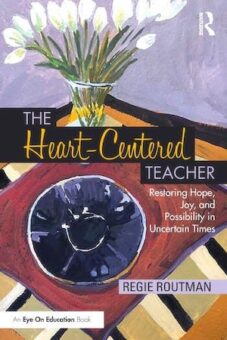10 Actions That Put Student Writers First

The single most effective strategy to successfully teach writing is this: Focus on the writer first and the writing second.
Writing can be difficult, messy, unpredictable work, even under favorable circumstances. Because we start with a blank page or blank screen, we feel vulnerable. As writers, we have to conjure up on our own what to put in those blank spaces. It’s scary for many and requires a courageous, risk taking spirit along with stamina and support.
Add in the social and emotional issues in these uncertain times when many of us – students, teachers and families – are feeling scared, lonely and isolated. All this requires us to put personal and positive human connections front and center, regardless of where teaching and learning occur – in person or at a distance.
Depending on how we teach, respond to, and assess writing, writing can be the vehicle to a learner’s success or an area where we do actual harm.
10 Actions and Attitudes
Uppermost in our minds when we confer and interact with a writer must be the goal of leaving the writer intact and hopeful, with a sense of self-worth and an “I can do it!” spirit that propels the learner forward with dignity and energy to do the work. Here are 10 ways we can be sure we are putting our writers first.
1. Ensure equity for all.
Holding high expectations, on the part of the writer and the teacher, is a necessity for the learner to be successful and fulfilled. Any system, school, or teacher that fosters and/or condones inequitable access to expert teaching and first-rate resources – even unconsciously – short changes students, often permanently. First and foremost, focus on the writer in ways that promote and encourage competence and confidence. This requires us to create and sustain a personal and caring culture of sensitivity, opportunity, and possibility for every learner.
2. Look for, acknowledge, and celebrate the writer’s strengths.
Regardless of age, the learners we teach need to know we see them as capable. Through expert and meaningful demonstrations, shared and guided experiences, and independent opportunities to “try and apply”, we “see”, name, and utilize each learner’s strengths and build upon them. It’s difficult for a reluctant writer to fully engage and make a genuine effort to improve in writing or any subject matter without that emotional safety net of ongoing guidance, support, and reassurance.
3. Choose language and actions carefully.
Monitor and silence your critical self. Maintain a mindset that encompasses each student’s full potential. Honor the writer’s intentions and efforts. Any feedback or stance we take must give the writer the energy, will, and purpose to go on writing.
4. Create a trusting, respectful culture.
An equitable culture includes a peaceful, organized, and safe environment. Avoid “gotcha” moments which deter students from taking risks and trying out something new that has been modeled. Provide sustained time for writing every day, including sufficient time for revising, redoing, and chances to do better. Students deserve second chances and grace, especially these days when life is so unpredictable for so many.
5. Co-create writing criteria with students.
Knowing the writing expectations in advance – the criteria or traits often referred to as a rubric – can help ensure students’ success. Develop these criteria with students, and be cautious not to treat required criteria as isolated skills. View the writing as a whole piece. Rely on the rubric once a first draft is completed, primarily as a way to assess, including students’ self-assessment of their strengths, needs, and next steps. Don’t let individual indicators/traits become the focus of the writing. Remember the intention of writing is to make meaning and that requires us to remain fully conscious of the “whole” of our writing piece.
6. Encourage an innovative spirit and more choice.
Is the writer courageous enough to reveal her true voice and thoughts? Why not encourage more topic choices along with original formats, ideas, and unique ways of thinking about the writing? With student participation, imagine audiences and purposes we may not have considered plus various and equitable ways to assess.
7. Listen closely during conferences.
When possible have the student first read aloud his writing or the portion on which he wants feedback. On this first reading, try not to scrutinize the paper, which may be messy and include obvious grammar and spelling issues. Think, focus, and listen: What is the writer trying to say? How can I best support those efforts.? Seek to gently guide. Adopt a facilitator stance; encourage the writer to take the lead. Listen for the writer’s voice.
8. Honor and respect the writer’s intentions and efforts.
It’s so easy for us to take over and direct students on what to do or even do it for them. If necessary, sit on your hands to avoid writing on a student’s paper when conferring. Teacher marks and remarks can quickly dominate a page – so much so that the writing no longer belongs to the student. Even with English learners and students in the early grades – where we might have difficulty reading the invented spelling – ask the student if it’s okay to write a conventional spelling lightly in pencil.
9. Write more short pieces.
It’s easier for the writer and the teacher to work on completing a piece – revising, editing, and publishing – if the piece is just a page or so. Poetry works well for that, so do book reviews, commercials, memoir snippets, news summaries, rap and song lyrics, “about the author” pieces, and much more.
10. Save editing for last.
Finally, focusing on the writer first means setting editing aside, for now. Even when you are demonstrating writing for your students, focus on the content. Do not stop to say, for example, “I’m putting an exclamation mark here because. . .” Just do it.
Writing is hard work. Put all your energy in what you are clearly and succinctly trying to say to your readers, and model that for students.
I learned this last lesson the hard way. When I first started writing books, I would request that my reader-responders remark solely on the content and ignore editing issues. Nevertheless, some readers felt compelled to bring my attention to every error in spelling, punctuation, and grammar.
Those “correctness” notations and marks on the manuscript were so distracting, I became convinced that focusing separately on content and ideas is a necessity if we are truly to prioritize the writer before the writing – and so help students nurture and strengthen their writer voices.
You can do it!
To sum up, seek to develop and sustain a mindset and actions that provide opportunity, dignity, and encouragement to each writer. Then, choose your language carefully – words and body language – and tailor feedback so it celebrates the writer’s strengths and boosts the writer’s confidence so he comes to see himself as a writer. Only then will each student be willing to engage in the hard, messy, joyful work we call writing.
Regie Routman is an educational leader, mentor, coach, and teacher who is passionate about improving the literacy and learning lives of all learners. For full information on Regie’s many books, articles, podcasts, videos, and resources – and to contact her – go to www.regieroutman.org and @regieroutman on Twitter and Facebook.

Regie is also the author of the bestselling 2018 Stenhouse book, Literacy Essentials: Engagement, Excellence, and Equity for All Learners. Here at MiddleWeb, Literacy Essentials has been reviewed an unprecedented four times by our contributors. Check out reviews by teacher and curriculum leader Sarah Cooper, literacy coach Pam Hamilton, improvement specialist Deana Jones, and principal and NBCT Rita Platt.
































Great Article. Must Use!
There are so many things I love about this post, Regie. Your focus on equity including HIGH expectations for ALL and your idea about writing short but very frequent pieces stand out as pearls of wisdom you share here. Thank you!